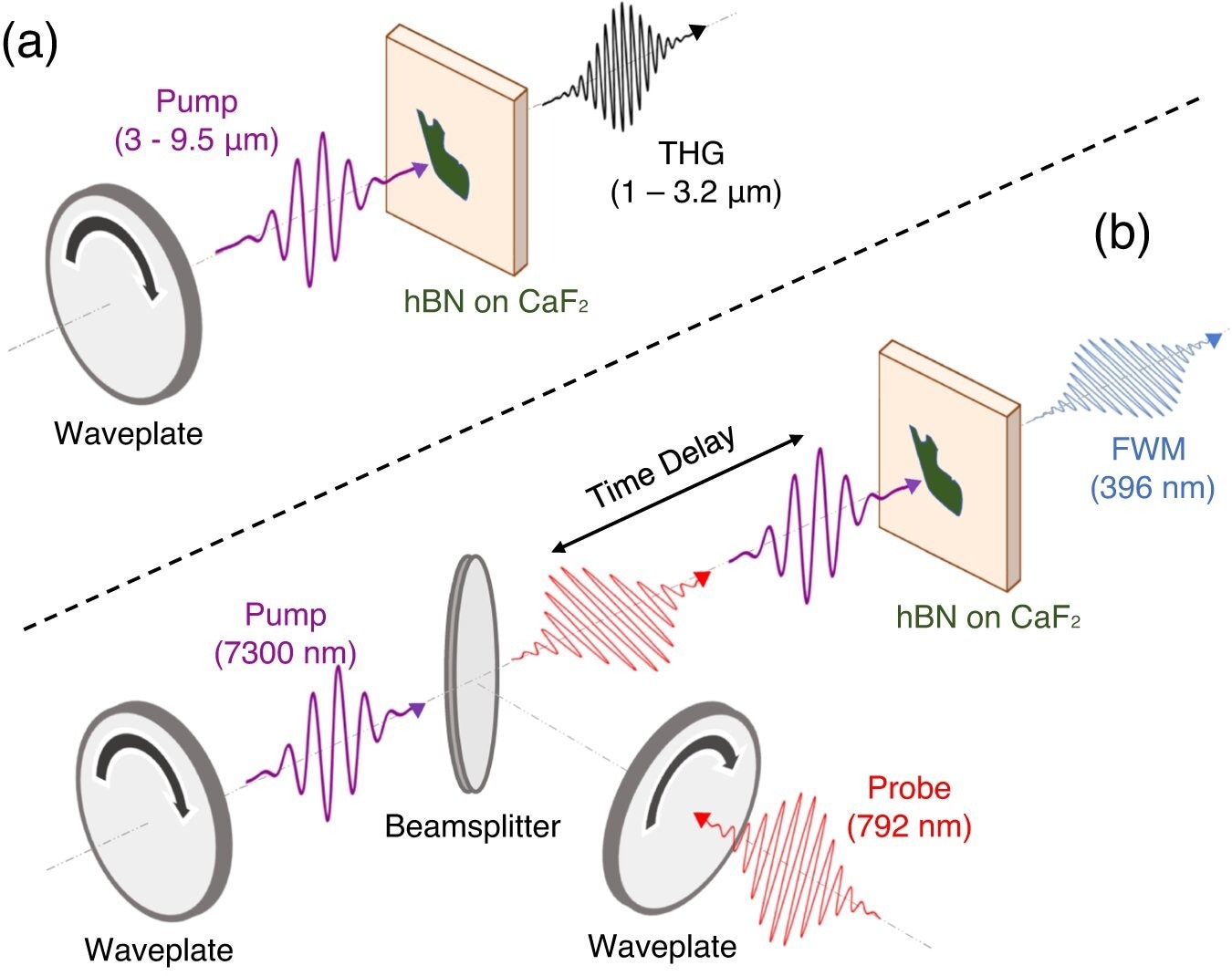By combining laser light with crystal lattice vibrations, engineers at Columbia University and their theoretical collaborators at the Max Planck for the Structure and Dynamics of Matter have discovered a way to improve the nonlinear optical characteristics of a layered 2D material. The study has been published in the Nature Communications publication.
 Setup for two experiments demonstrating phonon-enhanced nonlinearity in hBN, in transmission geometry. a Experimental setup for THG experiments. Detection is performed with PbS and MCT detectors, a lock-in amplifier, and boxcar-averaging. b Experimental setup for pump-probe FWM experiments. The time-delay is controlled by a mechanical delay stage with sub-1 µm step size. The pump and probe are both focused onto the sample with a reflective objective with 0.5 numerical aperture. Detection is performed with a silicon photomultiplier tube and lock-in amplifier. Image Credit: Nature Communications (2023). DOI: 10.1038/s41467-023-43501-x
Setup for two experiments demonstrating phonon-enhanced nonlinearity in hBN, in transmission geometry. a Experimental setup for THG experiments. Detection is performed with PbS and MCT detectors, a lock-in amplifier, and boxcar-averaging. b Experimental setup for pump-probe FWM experiments. The time-delay is controlled by a mechanical delay stage with sub-1 µm step size. The pump and probe are both focused onto the sample with a reflective objective with 0.5 numerical aperture. Detection is performed with a silicon photomultiplier tube and lock-in amplifier. Image Credit: Nature Communications (2023). DOI: 10.1038/s41467-023-43501-x
The new study’s co-author, Cecilia Chen, a Ph.D. student at Columbia Engineering, and her associates from Alexander Gaeta’s Quantum and Nonlinear Photonics group employed hexagonal boron nitride (hBN). Similar to graphene, hBN is a two-dimensional material with repeating honeycomb-shaped atom arrangement that can be peeled into thin layers with distinct quantum characteristics.
Chen pointed out that hBN is extremely light and stable at ambient temperature due to the boron and nitrogen that make up its components. This indicates that they vibrate rapidly.
Above absolute zero, all materials experience atomic vibrations. This motion could be quantized into quasiparticles known as phonons with specific resonances; in the instance of hBN, the researchers were interested in the optical phonon mode vibrating at 41 THz, which is equivalent to a wavelength of 7.3 μm, in the electromagnetic spectrum’s mid-infrared region.
While mid-IR wavelengths are viewed as short and therefore high energy in the context of crystal vibrations, they are viewed as very long and low energy in the vast majority of laser-based optics research, where the visible to near-IR range, roughly 400 nm to 2 μm, is the focus of most experiments and studies.
Together with fellow Ph.D. student Jared Ginsberg (now a data scientist at Bank of America) and postdoc Mehdi Jadidi (now a Team Lead at quantum computing company PsiQuantum), Chen and his team were able to efficiently generate new optical frequencies from the medium by tuning their laser system to the frequency of 7.3 μm for hBN.
This is an essential goal of nonlinear optics. The Max Planck group of Professor Angel Rubio conducted theoretical work that aided the experimental team in comprehending their findings.
They investigated the phonon-mediated nonlinear optical process of four-wave mixing to produce light that was almost equal to the harmonics of an optical signal using tabletop, commercially available mid-infrared lasers. Additionally, they saw a third-harmonic production rise of more than 30 times the amount that would be possible without phonon excitation.
We are excited to show that amplifying the natural phonon motion with laser driving can enhance nonlinear optical effects and generate new frequencies.
Cecilia Chen, Study Co-Author and Ph.D. Student, Columbia University School of Engineering and Applied Science, Columbia University
In subsequent studies, the team intends to investigate how light can be used to change hBN and similar materials.
Journal Reference:
Ginsberg, J. S., et. al. (2023) Phonon-enhanced nonlinearities in hexagonal boron nitride. Nature Communications. doi:10.1038/s41467-023-43501-x